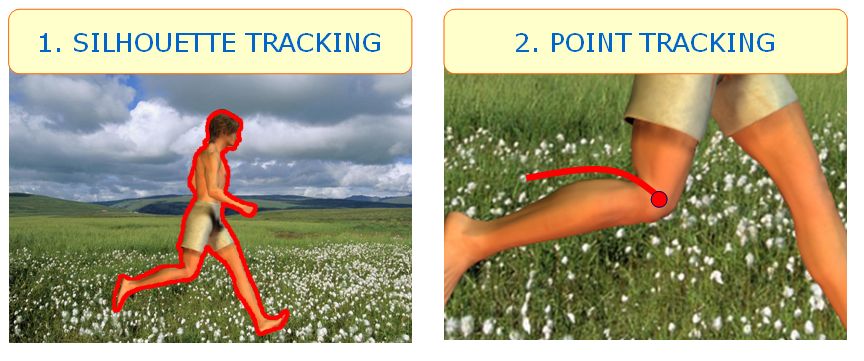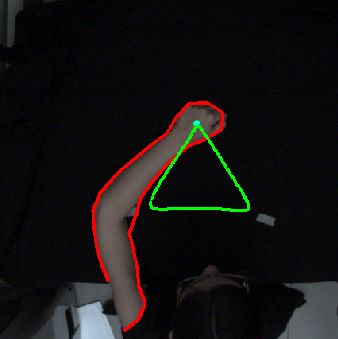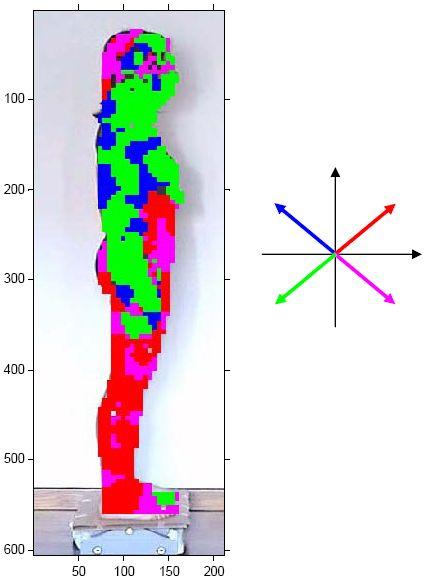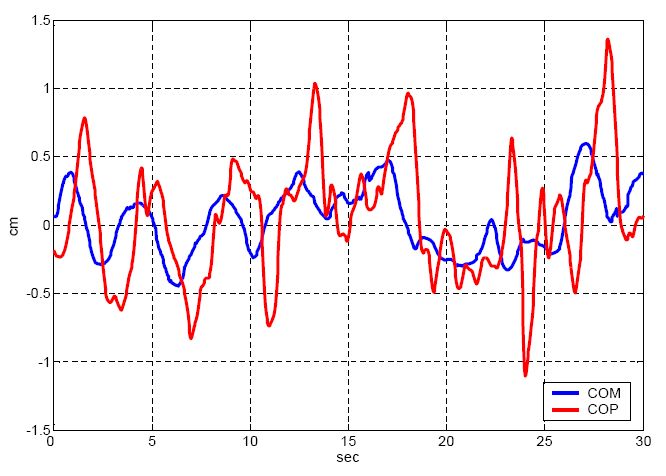Research Activities @ BioLab3 
Markerless Human Motion Analysis
| Objective |
|---|
| Design and implement a system for the analysis of human movement without external markers to be allocated on the subject?s body. |
| Description |
| Novel image processing techniques have been devised in the Lab to track relevant elements on the human body surface when performing various gestures, recorded by low cost video capturing devices. The fields of application of markerless systems are advanced user interfaces, sport studies, smart surveillance systems, virtual reality worlds, teleconferencing and telerehabilitation. In particular, referring to the rehabilitation context the possibility to monitor elderly people movements at home appears relevant. The aim of markerless is analysing human motion without markers in order to obtain information about the gesture-kinematics by applying image processing techniques to video sequences acquired with commercial digital cameras. In particular, this methodology presents, respect to the traditional marker-base sterephotogrammetry, the patients possibility of free moving and so the possibility of monitoring activities outside a laboratory or in home environment. Scientific literature on human motion estimation by analysing video sequences can be classified in the following group: model free and model based approaches. The first methods analyse video sequences in order to estimate the movement of regions of interest, usually enclosing relevant anatomical points, without any preliminary information about object shape. On the other hand, the model-based approaches use the information about human body shape in order to reconstruct the entire gesture kinematics. The markerless method we define is a model-free approach. It is composed by two consecutive steps which execute a coarse to fine motion estimation. The coarse phase consists in segmenting and tracking the human body silhouette during the movement. Then, a finer estimation allows to evaluate the trajectories of specific points which are relevant for the analysis of body segments kinematics. |
|
|
| Silhouette Tracking: NEURAL SNAKE ALGORITHM |
| The high deformability of human silhouette during movement and the consequent unacceptability to associate a rigid body approximation with it are critical problems in markerless motion analysis. Active Contour Models are widely used in literature for segmentation and contour detection but they are restricted to performing silhouette tracking of objects whose shape subtly changes during movement. For this reason they are not successfully applicable for human tracking during gait. We present a novel 2D markerless motion capture system for robust extraction of articulated silhouettes by a neural approach. We extend the classical active contour model formulation, known as Snakes , by using a Neural Network as a predictor for increasing the capability of this method in case of high deformable shapes. The proposed approach, called Neural Snakes, has been tested on several video sequences regarding the upper limb analysis during the execution of planar movements (rehabilitation, motor control analysis). |
|
|
| Point Tracking: GAUSS-LAGUERRE ALGORITHM |
| A Maximum Likelihood method for the markerless detection and tracking of relevant body points, working in the Gauss-Laguerre Transform (GLT) domain, has been used. The GLT is based on an orthogonal family of Circular Harmonic Functions, which permit optimal estimation of the position of a relevant point looking at the maxima of a ?Gauss-Laguerre Likelihood Map?. The proposed point tracking technique has been applied on several video sequences. The following figure present the result obtained with specific attention on the junctions involved during the Sit-to-Stand gesture: joint kinematics have been evaluated and reconstructed. |
| 3D Markerless Analysis |
| The simultaneous acquisition of video from different perspectives and the cameras calibration makes it possible to obtain a 3D analysis of human movement. |
|
| Posture Analysis |
| In posturographic applications, the presence of a force plate allows to integrate images and signals related to dynamics when recording movements, and to obtain information for the analysis of postural strategies in upright and perturbed stance. |
|
List of publications on the topic
| Publications on International Journals |
|---|
M. Goffredo, M. Schmid, S. Conforto, M. Carli, A. Neri, T. D'Alessio. Markerless Human Motion Analysis in Gauss-Laguerre Transform Domain: An Application to Sit-To-Stand in Young and Elderly People. Information Technology in Biomedicine, IEEE Transactions on, 13:2: 207-216, 2009 |
M. Goffredo, I. Bouchrika, J. N. Carter, M. S. Nixon. Performance analysis for automated gait extraction and recognition in multi-camera surveillance. Multimedia Tools and Applications, 50(1): 75-94, 2009 |
S. Conforto, M. Schmid, A. Neri, T. D'Alessio. A neural approach to extract foreground information from human movement images. Computer Methods and programs in Biomedicine., 82(1): 73-80, 2006 |
M. Goffredo, M. Schmid, S. Conforto, T. D'Alessio. A Markerless sub-pixel motion estimation technique to reconstruct kinematics and estimate the centre of mass in posturography. Medical Engineering and Physics, 28(7): 719-726, 2005 |
| Publications on International Books |
R. Seely, M. Goffredo, J. N.Carter, M. S. Nixon. View Invariant Gait Recognition. Handbook of Remote Biometrics, Springer, ISBN: 978-1-84882-384-6, 2009 |
| Contributions appeared on Proceedings of International Conferences |
C. D'Anna, A. Scorza, M. Schmid, F. Orsini, S.A. Sciuto, S. Conforto, S. Scena. A preliminary study on the validation of an automatic measurement method for functional reach assessment by stereophotogrammetry. IEEE International Instrumentation and Measurement Technology Conference (I2MTC), Turin: May 22-25, 2017 |
M. Goffredo, J. N. Carter, M. S. Nixon. 2D Markerless Gait Analysis. 4th European Conference of the International Federation for Medical and Biological Engineering, 22: 67-71, 2009 |
M. Goffredo, R. Muscillo, M. Gneo, M. Schmid, S. Conforto, T. D'Alessio. Estimation of Physical Performance for Elderly People via Markerless Sit to Stand Analysis. 11th International Congress of the IUPESM - Medical Physics and Biomedical Engineering, Munich, Germany: September 7-12, 2009 |
M. Goffredo, R. D. Seely, J. N. Carter, M. S. Nixon. Markerless View Independent Gait Analysis with Self-camera Calibration. IEEE International Conference on Automatic Face and Gesture Recognition 2008, 1: 73-80, 2008 |
M. Goffredo, S. Conforto, M. Schmid, T. D'Alessio. Human silhouette tracking by a neural approach: neural snakes. XVI International Society of Electrophysiology and Kinesiology ISEK Congress, Torino, Italy: June 29 -July 1, 2006 |
M. Goffredo, S. Conforto, M. Schmid, A. Neri, T. D'Alessio. Markerless evaluation of sit-to-stand strategy in Gauss-Laguerre domain. XVI International Society of Electrophysiology and Kinesiology ISEK Congress, Torino, Italy: June 29 -July 1, 2006, 2006 |
M. Schmid, D. Demirdjian, R. Hughes, T. D'Alessio, T. Darrell, P. Bonato. Markerless motion capture techniques to facilitate rehabilitation intervention. CIMIT Innovation Congress Boston, Boston, MA - USA: November 6-7, 2006 |
M. Goffredo, M. Schmid, S. Conforto, M. Carli, A. Neri, T. D'Alessio. Coarse-to-fine markerless gait analysis based on PCA and Gauss-Laguerre decomposition. Proc. SPIE Medical Imaging, 5747: 1076 , 2005 |
M. Goffredo, M. Schmid, S. Conforto, M. Carli, T. D'Alessio. Posture kinematics reconstruction and body model creation. Proc. SPIE Electronic Imaging, 5298: 136 , 2004 |
D. Bibbo, M. Goffredo, S. Conforto, M. Schmid, T. D'Alessio. Experimental setup for evaluating the accuracy of markerless human motion estimation techniques. Proc. IMEKO-IEEE-SICE 2004, Genova, Italy: June 14-16, 2004 |
Theses on the topic
| |
|
|
| Giacomo Severini | Algoritmi per analisi del campo di moto 2D:
valutazione delle prestazione per la correzione di occlusioni
(Bachelor's thesis, 2006) |
- |
| Simone Borzacchi | Inseguimento di silhouette nel movimento
umano: Neural Snakes (Masters thesis, 2005) |
- |
| Vito Castiglione | Stima del fattore di scala per un'analisi
markerless del movimento umano: ottimizzazione in linguaggio C
(Masters thesis, 2005) |
- |
| Nicola di Florio | Metodo per la gestione dell'effetto delle
occlusioni nella stima di traiettorie dell'arto inferiore (Masters
thesis, 2005) |
- |
| Giovanni Maruffa | Stima del movimento in sequenze di immagini
attraverso l'analisi del flusso ottico (Masters thesis, 2004)
|
- |
| Silvia Giacci | Uno studio sugli spazi di colore per l'elaborazione
di immagini markerless nell'analisi del movimento umano (Bachelor's
thesis, 2004) |
- |
| Mario Di Michele | Verifica delle prestazioni di algoritmi di
elaborazione di immagine per l?analisi del movimento umano (Bachelor's
thesis, 2004) |
- |
| Sergio Torcinaro | Acquisizione ed elaborazione di dati cinematici durante la pedalata (Bachelor's thesis, 2004) | - |
| Diego Torricelli | Algoritmi e tecniche per la ricostruzione 3D del movimento umano (Masters thesis, 2004) | - |
| Simone Maccagno | Elaborazione d?immagini per l?analisi del
movimento umano: algoritmi di stima e valutazione delle prestazioni
(Masters thesis, 2003) |
- |
| Michela Goffredo | Metodi di elaborazione di immagini per la
ricostruzione della cinematica in posturografia (Masters thesis,
2003) |
- |
| Roberto Lanzi | Analisi del movimento mediante tecniche
di stima di rotazione e traslazione: un algoritmo di ottimizzazione
in linguaggio C (Masters thesis, 2003) |
- |
| Ferruccio Cittadini | Stima di moto subpixel per applicazioni biomediche (Masters thesis, 2002) | - |






